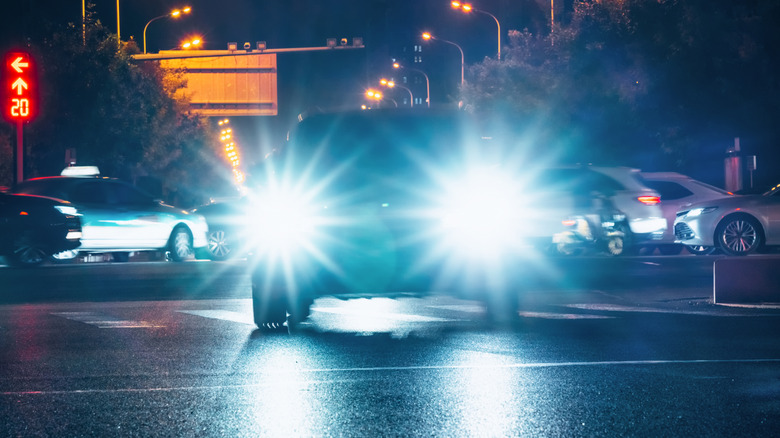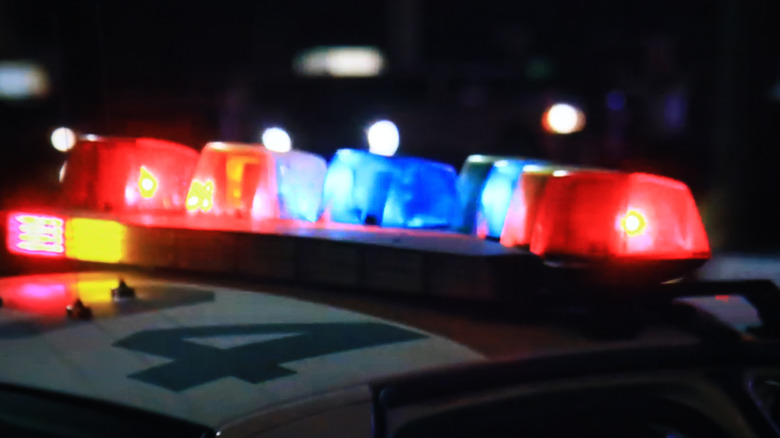Why Flashing Lights To Save You From A Ticket Could Backfire On Good Samaritans
Modern headlights have increased dramatically in brightness in recent years, and are necessary for driving safely at night. If you're in one of the states where yearly safety inspections are required, operational headlights are usually needed to pass, and broken ones can result in getting pulled over and receiving a ticket. But even if your headlights are in perfect order, using them in a certain way could get you in trouble with law enforcement, too.
As a courtesy, you might flash your headlights to alert other drivers of hazards such as police speed traps or animals, or to let them know you're giving them a chance to move. There are no federal laws deeming this illegal, and test cases have established headlight flashes as protected speech. However, using high beams within certain distances of other drivers can get you into legal trouble. The rules vary from state to state, with Michigan prohibiting flashing within 500 feet of an approaching vehicle, and New York specifying that lights must be dimmed 500 feet from oncoming traffic and 200 feet from the car ahead of you.
Since laws vary from state to state when it comes to high beam flashing, the punishments do as well.
Punishments for illegal use of high beams
High beams come standard on modern vehicles, acting as one of many ways to improve visibility when driving at night. They can simply be flicked on and off, increasing your field of view, and can be flashed to warn or otherwise communicate with other drivers.
In California, using high beams 500 feet ahead or 300 feet behind another driver can result in some major penalties. You could face a fine of $238 and have points added to your driving record.
Similarly in Florida, high beams are fine to use so long as you're not within 500 feet of an approaching vehicle or 300 feet behind one. If you flash your lights within this distance, you'll have committed a noncriminal traffic infraction, classified as a moving violation, and have to pay a civil penalty. Virginia requires the dimming of high beams at 500 feet ahead or 200 feet behind, with a possible fine of $81 should you fail to dip. Seemingly no matter where you are in the United States, high beam violations will have you needing to improve your driving record in the aftermath.
Of course, all of this hinges on the use of specifically high beams to get other drivers' attention. What if you merely flash your low beams to communicate with other motorists?
Headlight flashing isn't inherently illegal
While flashing your high beams in close proximity to other drivers is a safety concern, using them to communicate isn't inherently illegal. The defense of headlight flashing relies on the First Amendment of the United States Constitution, which guarantees free speech. A 1974 court case – Spence v. Washington – saw Harold Spence arrested for attaching a peace sign to a United States flag and displaying it in his window. Ultimately, it was decided by the Supreme Court that he hadn't violated any laws by doing so and that it was considered protected speech. He conveyed a specific message with his action that was likely to be understood by onlookers.
It has been argued that headlight flashing to communicate with drivers functions similarly. In states such as Texas and New York, for example, this practice has held up in court as entirely legal at safe distances. In recent decades, protected speech has been used to justify headlight flashing in multiple court cases. In November 2012, Missouri driver Michael Elli received a ticket for headlight flashing to warn of a speed trap. Thanks to his free speech defense, the court determined he and others in the area couldn't be ticketed for such action. Oregon driver Christopher Hill used the same defense, and Bill Walker of Tennessee had the case against him dismissed thanks to the First Amendment.
Whether you're just trying to see what's ahead, being a good Samaritan by warning other drivers of police and obstacles, or just trying to communicate, headlights can be as troublesome as they are helpful. Knowing the rules of the area and your rights is crucial to your safety, the safety of others, and your legal standing.


